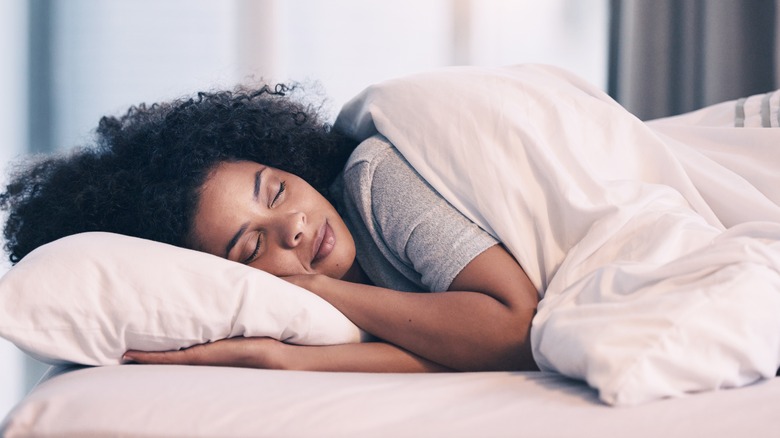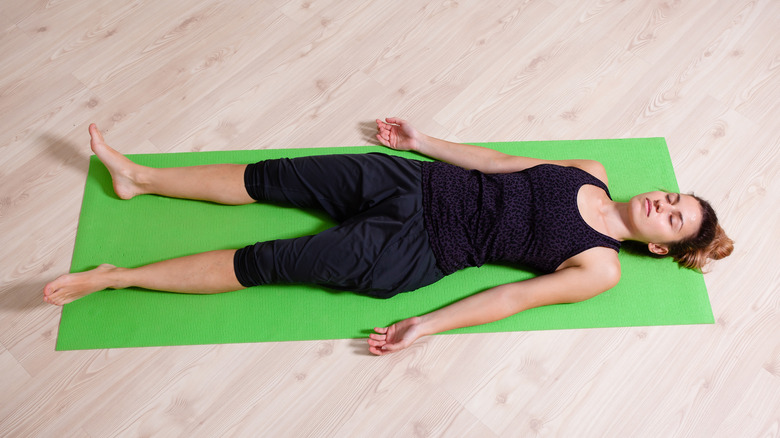Do This With Your Muscles To Fall Asleep In Record Time
Sometimes, it can feel like all the anxious thoughts you managed to keep at bay during the day crowd into your mind just when you're trying to get some sleep. Perfect. Now you're tossing and turning, willing the rumination away, and you're also starting to feel all tensed in your muscles. Is your mind running through tricks you need to try if you can't fall asleep at night?
Fortunately, there's a technique called progressive muscle relaxation that can help at times like these. It targets both your mind and your body and has been used by mental health practitioners and yoga teachers too. In yoga, the technique is called yoga nidra and is typically practiced at the end of a yoga session.
Progressive muscle relaxation combines mindful breathing with contracting and relaxing your muscles to induce restfulness and sleep. It was created by psychiatrist Dr. Edmund Jacobson in the 1920s as a means of helping patients with anxiety, and is also called Jacobson's relaxation technique. The idea is that by keeping the rest of your body relaxed and focusing on contracting and releasing the muscles in specific areas of your body progressively, you will be able to achieve complete muscle and mind relaxation and drift off to sleep. Here's how you do it.
How to do Jacobson's relaxation technique
Start by lying down in bed, on your back with your legs stretched beneath you and your arms on your side with your palms facing up. Close your eyes. You can place a pillow under your head and your knees if this is a more comfortable position for you. If it's cold in the room, cover yourself up with a blanket.
Take a few deep and slow breaths through your nose. Exhale. Begin the muscle contraction and release with your toes. You can either do both sets of toes (and legs) together or start with the right and move on to the left. Curl your toes inward as you inhale, and hold the contracted muscles in this position for a few seconds before relaxing them on the exhale. It's important to contract your muscles gently and not strain them too hard. The idea is to draw attention to how your muscles feel when they're contracted and when they're relaxed. You could use a guided relaxation found on YouTube if that helps.
Continue the same technique as you progress from your toes to your calf muscles, thighs, quads, hamstrings, buttocks, lower back, stomach, hands, arms, shoulders, neck, jaw, forehead, and face. Perform the contraction on the inhale, hold for a few seconds as you mindfully draw attention to how your muscles feel contracted, and exhale. Your muscles will start to feel heavy as they sink into the bed.
Why progressive muscle relaxation works
Progressive muscle relaxation has been linked with soothing anxiety, migraines, sleep issues, and even combating neck and back pain. In fact, per a 2012 study published in The Journal of Alternative and Complementary Medicine, progressive muscle relaxation technique (PMRT) was associated with relieving fatigue and improving sleep quality in patients with multiple sclerosis.
A 2020 study published in the journal Burns found that doing Jacobson's relaxation technique 20 to 30 minutes daily for three consecutive days decreased anxiety and improved sleep quality in burn patients when compared with the control group, who only received routine care and treatment. Meanwhile, a 2015 study published in the Journal of Education and Health Promotion linked progressive muscle relaxation with improved postpartum sleep quality in mothers.
Mindful breathing has been a part of religious and medicinal practice for years now. It helps calm your nervous system. And bringing attention to your body — by contracting and relaxing muscles — helps you in two ways: distracting you from your anxious nighttime rumination and forcing you to focus on physical sensations instead, and actually helping your muscles release the tensions of the day. Carrying the stressors of the day in your muscles could be one of the things you didn't realize was ruining your sleep. So go ahead and try this relaxation technique the next time you're wide awake and staring at the ceiling.


